Featured Image Credit: NASA/Joel Kowsky
Lift Off Time | July 30, 2020 – 11:50 UTC | 07:50 EDT |
|---|---|
Mission Name | Mars 2020 Perseverance, NASA’s next Mars rover |
Launch Provider | United Launch Alliance (ULA) |
Customer | NASA (National Aeronautics and Space Administration) |
Rocket | Atlas V 541 |
Launch Location | Space Launch Complex (SLC)-41, Cape Canaveral Air Force Station (CCAFS), United States of America |
Payload mass | 1050 kg (about 2315 pounds) |
Where did the payload go? | Jezero Cater, Mars |
Did they attempt to recover the first stage? | No, this is not a capability of ULA |
Where did the first stage land? | It crashed into the Atlantic Ocean |
Did they attempt to recover the fairings? | No, this is not a capability of ULA |
Were these fairings new? | Yes |
This was the: | – 4th flight for ULA in 2020 – 140th flight for ULA all-time – 4th flight of an Atlas V in 2020 – 85th flight of an Atlas V all-time |
Where to re-watch: | Official launch replay (NASA) Official landing replay (NASA) Everyday Astronaut launch replay Everyday Astronaut landing replay |
How did it go?
After six months of cold space travel, the Perseverance rover, as part of the Mars 2020 mission, has safely touched down on Mars at 20:43 UTC with the signal being received at 20:55 UTC. The sequence from cruise stage separation to the sky crane deployment and lowering of the rover, everything was nominal and Mars now has another human-made marvel on its surface. Shortly after touchdown, Perseverance began taking images of the surface and its surroundings so scientists and engineers had a better idea as to where Perseverance landed.

Perseverance Landing Location
During the post landing press briefing, the media and members of the public on social media had the opportunity to ask questions regarding the landing and future operations to be conducted in the coming days and weeks. A majority of the media had questions about the descent HD video, coming Monday, and the exact landing location.

The above image illustrates the landing zone for Perseverance. A blue circle indicates the target zone that the team gave for Mars 2020 near the river delta of the Jezero Crater. The pinhead with the rover on it is the exact location of landing on the Martian surface.
Below is a hazard map of the landing done for Mars 2020. The red indicates areas where landing could’ve resulted in failure or partial failure, while the blue areas were approved for a safe landing. As is visible, the Perseverance rover was able to use its Terrain Relative Navigation to guide it to a blue area in a sea of red.

How did Perseverance get to Mars?
Atlas V Launch
Perseverance started on ULA’s Atlas V 541 which lifted off from SLC-41, CCAFS at 9:35 am EDT with the Perseverance rover in its 5 meter fairing. Climbing to an initial orbit of 270 km (167 miles), the Centaur upper stage then boosted the rover towards Mars. The accuracy of the launch was to ULA standards only using 3.3% of the requirement for a successful launch towards Mars, that’s a bullseye.
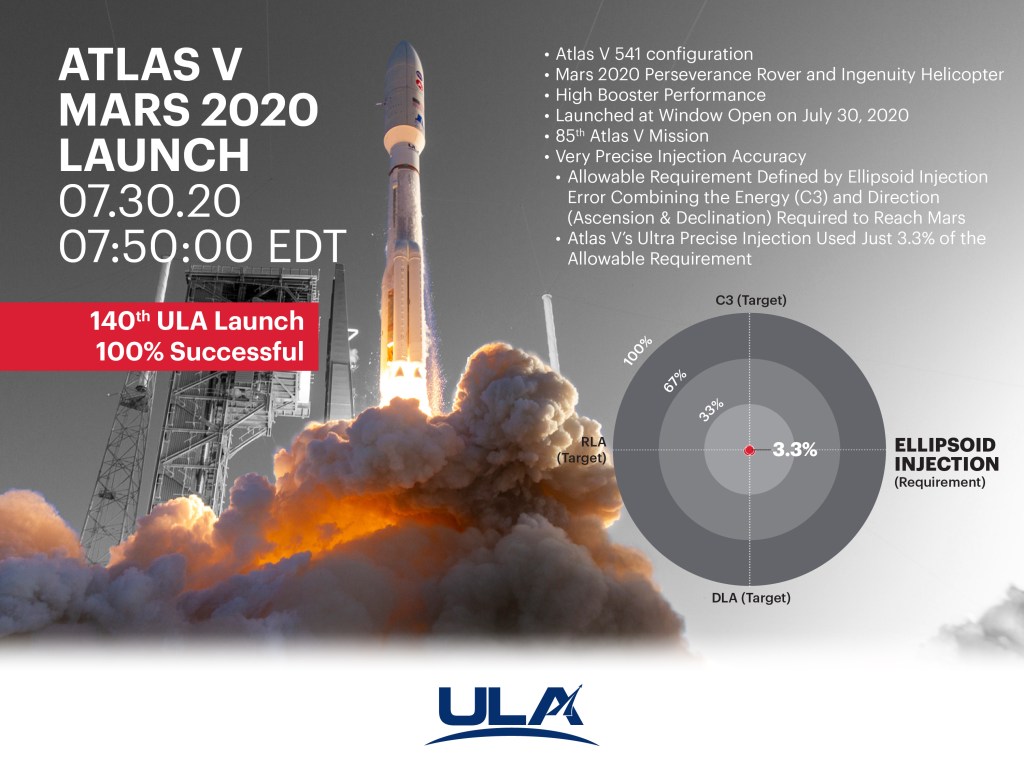
Perseverance Cruise/Approach
The only part of the spacecraft left was Perseverance which is enclosed in its aeroshell. This shell acts as protection, but also hosts the power and course correction propulsion systems. Throughout this time, mandatory health and communications checks were performed by NASA’s specially trained team of engineers and mission specialists. Towards the end of this phase, preparations began for the Entry, Descent and Landing (EDL).
Mars 2020 Entry, Descent and Landing (EDL)
Also known as the “7 minutes of terror”, this phase of Perseverance’s flight is dubbed as the most terrifying by engineers and space fans. Due to the fact that Mars is so far away from Earth and communications are limited to the speed of light, the transmission signals can take about 12 minutes to reach Earth. That’s a 24 minutes round-trip. All the data that the teams saw happened 12 minutes prior. By the time engineers received the signal that Perseverance had entered the atmosphere, it was already on the ground.
EDL Phase Timeline
| Entry – 10 minutes | Cruise stage separated and burned up in the Martian atmosphere |
| Entry +/- 0 minutes | Entry into the Martian atmosphere began |
| Entry + 80 seconds | At roughly 2,100 degrees Celsius, the heat shield experienced maximum heating |
| Entry + 90 seconds | The craft experienced the maximum deceleration. Slowing down from 21,200 km/h (13,200 mph) to just 1600 km/h (1,000 mph) in only two and a half minutes |
| Entry + 240 seconds | The parachute deployed at an altitude of 9 to 13 km (6 to 8 miles) |
| Entry + 260 seconds | Heat shield separation and the ground radar systems activated to define a suitable landing area |
| Entry + 350 seconds | Back shell separation as the rover began a moment of freefall before the landing motors on the Skycrane ignited |
| Touchdown! | At around 21 meters (70 feet), the rover separated from the landing stage tethered to it by three nylon ropes and was gently set down at 2.7 km/h (1.7 mph). The landing stage then flew away and crashed into the surface at a safe distance. |
Surface Operations
Surface Operations have yet to begin as Perseverance has just arrived on the surface. They will commence in a few days and weeks. Some of the initial operations included deployment of the communications antennae and taking images of its surroundings. The mission is scheduled to last about one Martian year, or 687 Earth days. However, the team will often refer to mission days as “Sols” or Martian days. In this case, the mission will last 669 sols. The first 90 sols will consist of initial checkouts of all of Perseverance’s systems to ensure that they are all functioning properly.
During this initial period, the team will be on Martian time, which means starting their shifts 40 minutes earlier each day because one Sol is approximately 40 minutes longer than one Earth day.
Keep an eye out on the Mars 2020 website for future updates on surface operations after touchdown!
What did Perseverance take to Mars?
The payload consists of the Perseverance rover and the attached drone, Ingenuity. The Perseverance rover is the most complex and most technologically advanced piece of hardware to travel to another planet. Similar in shape/size to the former, and still operating, Curiosity rover, launched on November 26, 2011, Perseverance is only 126 kg (278 pounds) heavier and 13 cm (5 inches) longer. Taking a big step up from the Curiosity rover, Perseverance will have similar, but more advanced instruments focused on sample collection for future return to Earth.
| Mars 2020 Instruments | Mastcam-Z | PIXL | MEDA | MOXIE | RIMFAX | SHERLOC | SuperCam |
|---|---|---|---|---|---|---|---|
| What’s the instruments main purpose? | Image the Martian surface in high-definition video, high resolution panoramas and in 3D. | Measure the chemical composition of the rocks on the Martian surface at a finite scale. | Act as a mini weather station on Perseverance | Demonstrate carbon dioxide to oxygen conversion for future human exploration of the red planet. | See sub-surface features using ground penetrating radar | Detect minerals, potential biosignatures and organic molecules on a very finite scale. | Study the atomic and molecular composition of rocks and soil |
| Where on the rover is it located? | The mast at about 2 meters (6.5 feet) high | The turret at the end of the robotic arm. | The neck of the mast and on the front of the body of Perseverance. | The front right side, inside the rover. | The lower rear of the rover as a radar antenna. | The turret at the end of the robotic arm. | The turret at the end of the robotic arm. |
| How much power does this instrument draw? | ~ 17.4 watts | ~ 25 watts | ~ 17 watts, measurement dependent | ~ 25 watts | ~ 5-10 watts | Turret: 32.2 watts Body: 16.6 watts | Turret: 32.2 watts Body: 16.6 watts |
| What is the data return speed? | ~ 148 Mbits per sol | ~ 16 Mbits per experiment ~2 Megabytes per Sol | ~ 11 Megabytes per day | n/a | ~ 5 to 10 Kilobytes per sounding location | ~ 79.7 Mbits per day | ~ 4.2 Mbits per day |
| Any other special information? | 1600 x 1200 maximum image size | Frequency range of 150-1200 megahertz; 10 meter (30 feet) depth |

Ingenuity Drone
Perseverance will be accompanied by a technology demonstration drone. This will be the first time that humans have conducted powered flight on another planet. The drone, dubbed Ingenuity weighs just 1.8 kg (4 pounds).
Key Objectives
- Demonstrate the ability to perform powered flight in the thin atmosphere of Mars
- Demonstrate the technology of miniaturized flying on another celestial body
- To operate totally autonomously
Key Features
- Recharges independently and is solar powered
- Communicates with Perseverance at a maximum 1 km (0.6 mi) radius, Perseverance then relays the signal back to Earth
- Two carbon fiber counter rotating 1.2 meter (4 foot) long blades to provide lift in the thin atmosphere
- Equipped with one color and one black and white camera
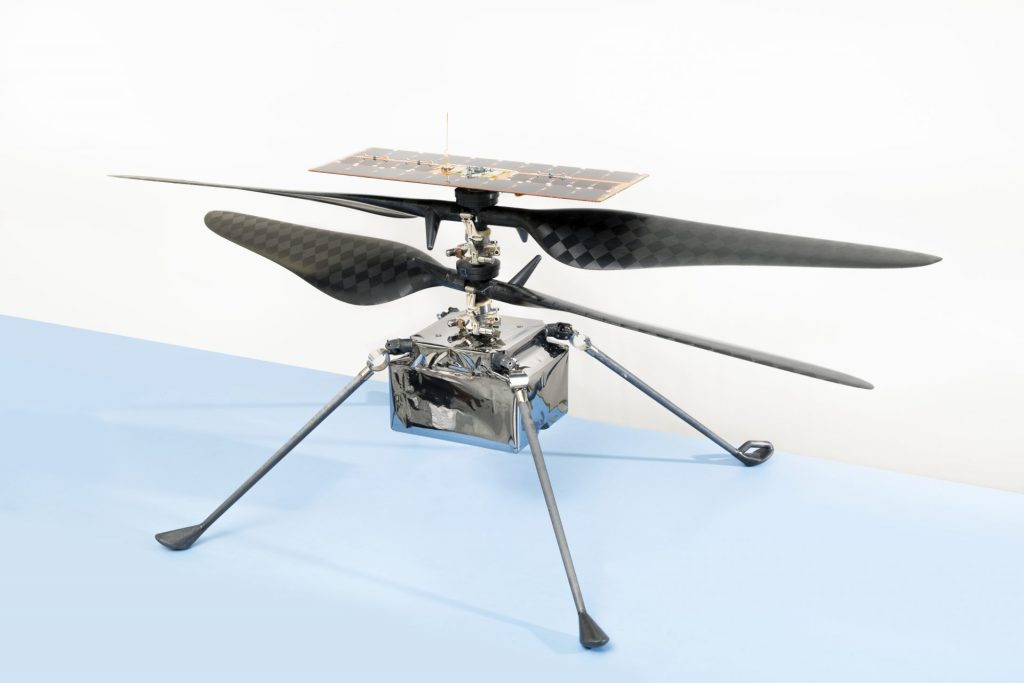
What rocket propelled Perseverance to Mars?
For the Mars 2020 mission, the configuration of the Atlas V is a 541 configuration. The last three numbers or letters in the Atlas V’s name denote the configuration of the rocket. The first number/letter shows the fairing diameter size (in meters, of course) and ‘N’ for no fairing. The number 5 in this case stands for a 5 meter fairing. Following, the second number determines the number of strap on solid rocket boosters (SRBs) which can range from 0 to 5, and in this case, there are four strapped on to the side of the center common core. Finally, the number refers to the number of engines on the Centaur Upper Stage, which can be either one or two. In this case there is one engine. The only time that there has been two engines (on an Atlas V) was on Starliner’s OFT-1. So to summarize, for the Mars 2020 mission, this rocket has a 5 meter fairing, 4 solid rocket boosters, and 1 engine on the Centaur Upper Stage.

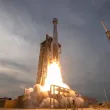
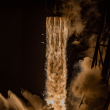

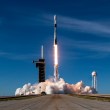


I love that it launched on my birthday, makes me feel special.
happy (very) belated birthday!
I remember seeing this launch from the cape, it was amazing to see! It was the first launch I ever saw, and it filled me with so much excitement when there was touchdown confirmation and I saw the first image it had taken.